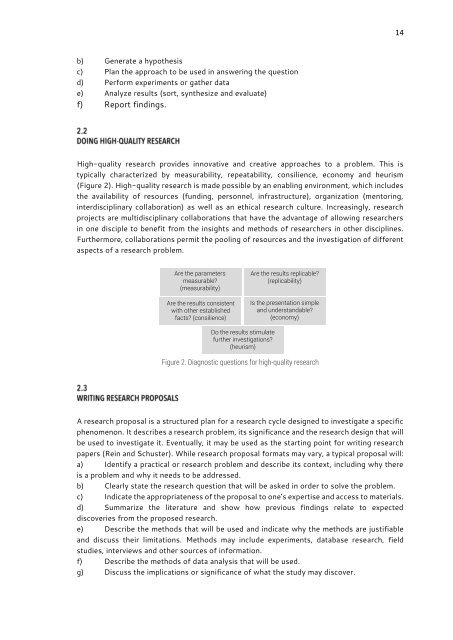A up RESEARCH GUIDEBOOK
33DSJ3
33DSJ3
Create successful ePaper yourself
Turn your PDF publications into a flip-book with our unique Google optimized e-Paper software.
14<br />
b) Generate a hypothesis<br />
c) Plan the approach to be used in answering the question<br />
d) Perform experiments or gather data<br />
e) Analyze results (sort, synthesize and evaluate)<br />
f) Report findings.<br />
High-quality research provides innovative and creative approaches to a problem. This is<br />
typically characterized by measurability, repeatability, consilience, economy and heurism<br />
(Figure 2). High-quality research is made possible by an enabling environment, which includes<br />
the availability of resources (funding, personnel, infrastructure), organization (mentoring,<br />
interdisciplinary collaboration) as well as an ethical research culture. Increasingly, research<br />
projects are multidisciplinary collaborations that have the advantage of allowing researchers<br />
in one disciple to benefit from the insights and methods of researchers in other disciplines.<br />
Furthermore, collaborations permit the pooling of resources and the investigation of different<br />
aspects of a research problem.<br />
Are the parameters<br />
measurable?<br />
(measurability)<br />
Are the results consistent<br />
with other established<br />
facts? (consilience)<br />
Are the results replicable?<br />
(replicability)<br />
Is the presentation simple<br />
and understandable?<br />
(economy)<br />
Do the results stimulate<br />
further investigations?<br />
(heurism)<br />
Figure 2. Diagnostic questions for high-quality research<br />
A research proposal is a structured plan for a research cycle designed to investigate a specific<br />
phenomenon. It describes a research problem, its significance and the research design that will<br />
be used to investigate it. Eventually, it may be used as the starting point for writing research<br />
papers (Rein and Schuster). While research proposal formats may vary, a typical proposal will:<br />
a) Identify a practical or research problem and describe its context, including why there<br />
is a problem and why it needs to be addressed.<br />
b) Clearly state the research question that will be asked in order to solve the problem.<br />
c) Indicate the appropriateness of the proposal to one’s expertise and access to materials.<br />
d) Summarize the literature and show how previous findings relate to expected<br />
discoveries from the proposed research.<br />
e) Describe the methods that will be used and indicate why the methods are justifiable<br />
and discuss their limitations. Methods may include experiments, database research, field<br />
studies, interviews and other sources of information.<br />
f) Describe the methods of data analysis that will be used.<br />
g) Discuss the implications or significance of what the study may discover.




